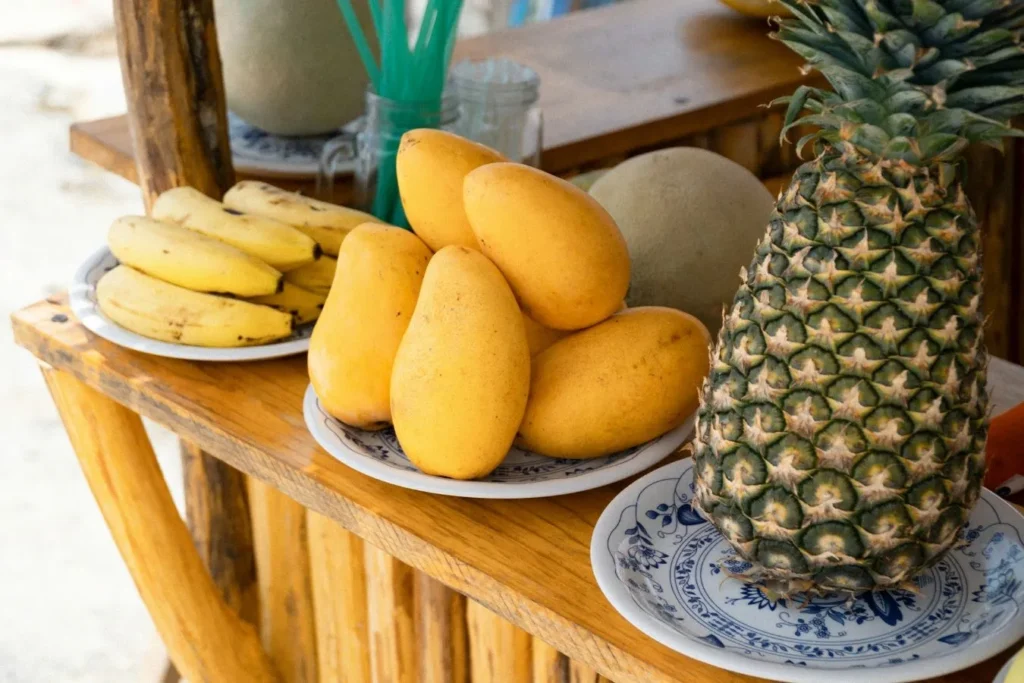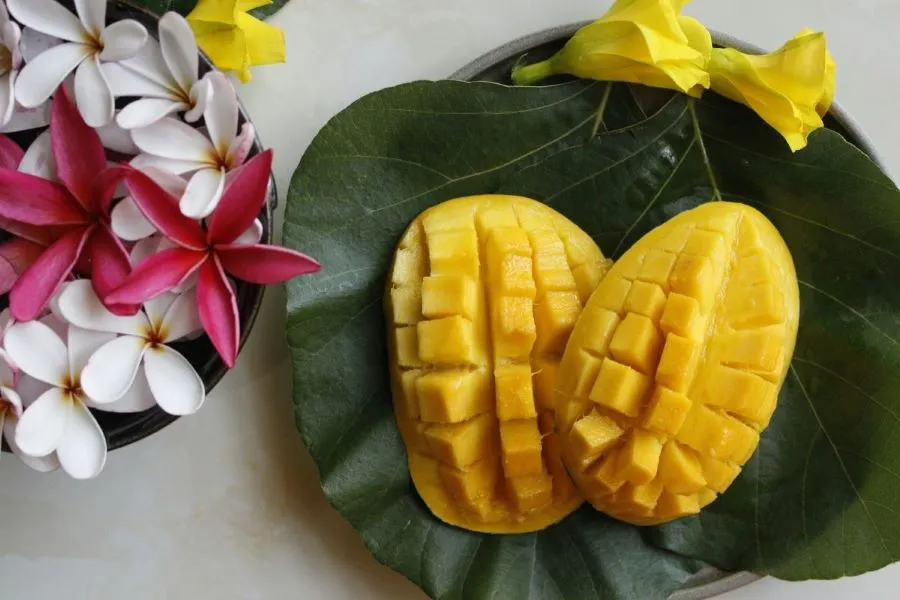Introduction
Mangoes are often called the “king of fruits,” and for good reason. With their vibrant colors, succulent flavors, and impressive nutritional profile, mangoes have captured the hearts and palates of people worldwide. Whether you enjoy them fresh, dried, or in a smoothie, there’s no denying the allure of this tropical fruit. Join me on a delightful journey as we explore the history, varieties, nutritional benefits, health tips, culinary uses, and cultural significance of mangoes. Along the way, I’ll share some personal anecdotes and fun facts to make our exploration even more engaging.
A Brief History of Mangoes
The history of mangoes dates back over 4,000 years to the Indian subcontinent, where they were first cultivated. Ancient Hindu scriptures, such as the Vedas, mention the mango tree and its fruit, highlighting its significance in Indian culture. The mango tree is also associated with various deities in Hindu mythology, symbolizing love, fertility, and prosperity.
Mangoes gradually spread to other parts of Asia and eventually reached Africa, the Middle East, and the Americas. The Portuguese significantly introduced mangoes to Africa and Brazil during the 15th and 16th centuries. Today, mangoes are grown in tropical and subtropical regions around the globe, with India, China, Thailand, Indonesia, and the Philippines being some of the top producers.
Varieties of Mangoes
One of the most exciting aspects of mangoes is the sheer variety available. There are over 500 different types of mangoes, each with its own unique flavor, texture, and aroma. Here are some popular varieties you might encounter:
1. Alphonso
Often hailed as the “king of mangoes,” Alphonso are known for their rich, creamy texture and sweet, buttery flavor. They are primarily grown in the Ratnagiri region of India and are highly sought-after during the mango season.
2. Haden
Originating from Florida, Haden mangoes are large, vibrant, and slightly tangy. Their bright red and green skin makes them visually appealing, and they are perfect for fresh consumption or in salads.
3. Ataulfo
Also known as Honey or Champagne mangoes, Ataulfo mangoes are small, yellow, and have a creamy, custard-like flesh. They are incredibly sweet and less fibrous than other varieties, making them a favorite for smoothies and desserts.
4. Kent
Kent mangoes are green with a red blush and have a juicy, sweet, and slightly tangy taste. They are perfect for making mango salsa or adding to tropical fruit salads.
5. Tommy Atkins
Tommy Atkins, are widely available in supermarkets and have thick skin and firm flesh. They are less sweet than other varieties. Kent mangoes are green with a red blush and have a juicy, sweet, and slightly tangy taste. They are perfect for making mango salsa or adding to tropical fruit salads.
Nutritional Benefits of Mangoes
Mangoes are delicious and packed with essential nutrients that can benefit your health in numerous ways. Here are some of the key nutritional benefits of them:
1. Rich in Vitamins and Minerals
Mangoes are an excellent source of vitamins A and C. Vitamin A is crucial for maintaining healthy vision, skin, and immune function, while vitamin C is a powerful antioxidant that helps boost the immune system and promote collagen production.
2. High in Fiber
Mangoes are rich in dietary fiber, which aids digestion and helps prevent constipation. Consuming fiber-rich foods can also support heart health by lowering cholesterol levels.
3. Antioxidant Powerhouse
They contain several antioxidants, including beta-carotene, quercetin, and mangiferin. These compounds help protect the body against oxidative stress and reduce the risk of chronic diseases such as cancer and heart disease.
4. Supports Skin Health
The vitamins and antioxidants in mangoes contribute to healthy, glowing skin. Vitamin C promotes collagen production, while vitamin A helps repair and regenerate skin cells.
5. Aids in Weight Management
Mangoes are relatively low in calories and can be a satisfying addition to a weight management plan. Their natural sweetness can help curb sugar cravings, making them a healthier alternative to processed sweets.
Health Tips for Enjoying Mangoes
While they are undoubtedly nutritious, it’s essential to enjoy them in moderation and be mindful of a few health tips:

1. Watch Your Portions
Mangoes are naturally high in sugar, so it’s essential to enjoy them in moderation, especially if you have diabetes or are watching your sugar intake. A serving size of about one cup of mango slices is generally recommended.
2. Pair with Protein
To balance the natural sugars in mangoes, pair them with a source of protein, such as Greek yogurt, cottage cheese, or nuts. This combination can help stabilize blood sugar levels and keep you feeling full longer.
3. Be Mindful of Allergies
Some people may be allergic to mangoes, particularly those who are sensitive to latex or poison ivy. If you experience itching, swelling, or difficulty breathing after consuming mangoes, seek medical attention immediately.
4. Ripe vs. Unripe Mangoes
Ripe mangoes are sweeter and juicier, making them perfect for fresh consumption. Unripe mangoes, on the other hand, have a tangy flavor and can be used in savory dishes like pickles and chutneys.
5. Store Properly
To extend the shelf life of mangoes, store them at room temperature until they ripen. Once ripe, they can be refrigerated for a few days. If you have an abundance of mangos, consider freezing them for smoothies and other recipes.
Culinary Uses of Mangoes
They are incredibly versatile and can be used in a wide range of culinary creations, from sweet to savory. Here are some delicious ways to enjoy mangoes in your cooking:
1. Mango Smoothie
A refreshing mango smoothie is perfect for a hot summer day. Blend fresh or frozen mango chunks with a splash of orange juice, a dollop of Greek yogurt, and a handful of ice. For an added nutritional boost, toss in some spinach or kale.
2. Mango Salsa
Mango salsa is a delightful accompaniment to grilled fish, chicken, or tacos. Combine diced mangoes with red onion, jalapeño, cilantro, lime juice, and a pinch of salt. The result is a vibrant and flavorful salsa that adds a tropical twist to your dishes.
3. Mango Lassi
A popular Indian beverage, mango lassi is a creamy and delicious drink made with mangoes and yogurt. Blend ripe mangoes with plain yogurt, a touch of honey, and a pinch of cardamom. Serve chilled for a refreshing treat.
4. Mango Salad
For a light and refreshing salad, toss together diced mangoes, avocado, cherry tomatoes, red onion, and mixed greens. Drizzle with a tangy lime vinaigrette and sprinkle with toasted almonds for added crunch.
5. Mango Sorbet
Mango sorbet is a simple and healthy dessert that requires just a few ingredients. Puree ripe mangoes with a bit of sugar and lime juice, then freeze the mixture until firm. Scoop into bowls and enjoy a naturally sweet and refreshing treat.
6. Mango Curry
In many South Asian cuisines, they are used in savory dishes like curries. A mango chicken curry combines the sweetness of mangoes with aromatic spices for a flavorful and comforting meal. Simmer chicken pieces with onions, garlic, ginger, coconut milk, and ripe mango chunks, and serve over rice.
Personal Anecdotes and Fun Facts
Growing up, mangoes were a staple in my household, especially during the summer months. I have fond memories of my family gathering around a large bowl of freshly sliced mangoes, enjoying the juicy sweetness and sticky fingers that followed. My grandmother would often make a traditional Indian mango pickle, using unripe mangoes, spices, and oil. The tangy and spicy pickle was the perfect accompaniment to our meals and added a burst of flavor to even the simplest dishes.
Did you know that in some cultures, they are considered symbols of love and friendship? In India, it’s common to send a basket of mangoes as a gift to friends and family during the mango season, signifying affection and goodwill.
Another fun fact is that the mango is the national fruit of India, Pakistan, and the Philippines. There’s even a festival dedicated to mangoes in India called the International Mango Festival, where you can sample different varieties, participate in mango-eating contests, and learn about the cultivation and history of this beloved fruit.
Vitamins and Minerals
They are low in fat and contain no cholesterol, making them a heart-healthy food choice. They are also rich in vitamins A and C, which are essential for immune function, skin health, and vision. Additionally, the fiber content in mangoes aids in digestion and helps maintain a healthy gut.
Here is a table summarizing the nutrition facts for (per 1 cup, sliced, 165 grams):
| Nutrient | Amount per Serving | % Daily Value |
| Calories | 99 | – |
| Total Fat | 0.6 grams | – |
| Saturated Fat | 0.2 grams | – |
| Trans Fat | 0 grams | – |
| polyunsaturated Polyunsaturated Fat | 0.07 grams | – |
| Monounsaturated Fat | 0.14 grams | – |
| Cholesterol | 0 milligrams | – |
| Sodium | 2 milligrams | – |
| Total Carbohydrates | 25 grams | – |
| Dietary Fiber | 2.6 grams | – |
| – Sugars | 23 grams | – |
| Protein | 1.4 grams | – |
| Vitamin A | 1,785 IU | 36% |
| Vitamin C | 60.1 milligrams | 67% |
| Vitamin E | 1.5 milligrams | 8% |
| Vitamin K | 6.9 micrograms | 6% |
| Thiamin (Vitamin B1) | 0.045 milligrams | 4% |
| Riboflavin (Vitamin B2) | 0.055 milligrams | 4% |
| Niacin (Vitamin B3) | 0.826 milligrams | 5% |
| Vitamin B6 | 0.197 milligrams | 12% |
| Folate (Vitamin B9) | 23.1 micrograms | 6% |
| Pantothenic Acid (B5) | 0.264 milligrams | 5% |
| Calcium | 18 milligrams | 1% |
| Iron | 0.264 milligrams | 1% |
| Magnesium | 19.8 milligrams | 5% |
| Phosphorus | 18 milligrams | 1% |
| Potassium | 277 milligrams | 8% |
| Zinc | 0.127 milligrams | 1% |
| Copper | 0.228 milligrams | 25% |
| Manganese | 0.056 milligrams | 2% |
| Beta-Carotene | 445 micrograms | – |
| Alpha-Carotene | 15 micrograms | – |
| Antioxidants | Quercetin, Mangiferin | – |
Which is sweeter: mango juice or pineapple juice? If you had no other choice, which one would you drink?
Mango juice is generally sweeter than pineapple juice. Mangoes have a higher natural sugar content, which gives the juice a rich, smooth sweetness. Pineapple juice, while sweet, also has a tangy acidity that balances out the sweetness.
If I had no other choice, I would choose mango juice. Its sweetness and creamy texture make it enjoyable and refreshing. However, the choice can also depend on your taste preference for sweetness versus tanginess.




